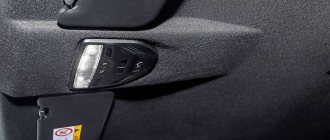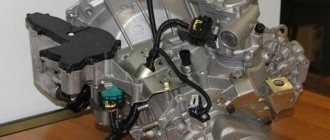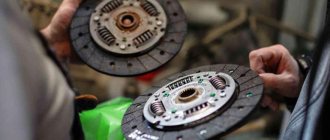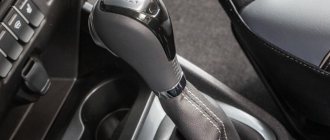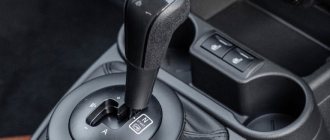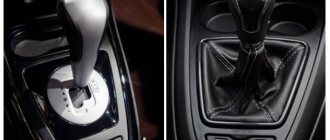At the end of 2022, the brainchild of AvtoVAZ went on sale - the new LADA Vesta SW Cross station wagon, which has already made a good splash. People are interested and search for information on the Internet, look at reviews, stand in line at car dealerships... And for good reason. The car turned out to be very beautiful and inexpensive, unlike its predecessors.
But it so happened that Vesta did not receive the classic machine gun. AvtoVAZ explained this by saying that the refusal to use automatic transmissions is due to cheaper designs. Installing an automatic transmission would entail an inevitable increase in costs. But, as an alternative, the AMT Lada Vesta Cross was chosen.
In addition to the robotic gearbox, a traditional 5-speed manual will also be available. But today we are not talking about her. Before starting the article about the Lada Vesta SV robot, I will make another reservation. Both transmissions presented will work together with 1.6 liter gasoline engines with a power of 106 hp. and 122-horsepower 1.8 liters. The robot will only be installed in conjunction with a 1.8 liter engine.
Prices
In identical configurations, the robot requires an additional payment for the “handle” of 25,000 rubles, regardless of the engine - 1.6 or 1.8. But these are 2022 cars. The CVT on cars produced in 2022, if you count the difference with the base 1.6 engine with manual transmission, raises the price by 95 thousand. Quite a lot! Regarding the 1.8‑liter engine, the surcharge is less - 60 thousand rubles.
Reduced gear shift time: AMT 2.0 compared to the previous version, ms
| Percentage of pressing the accelerator pedal | From first to second | From second to third |
| 30 | 730 | 720 |
| 60 | 690 | 880 |
| 100 | 680 | 550 |
The nuances of driving the Vesta robot
As with all cars, when driving a Lada robot, there are some nuances that should be taken into account when purchasing. They can be understood most clearly if you read the reviews about the robot on Vesta. For example, the gearbox is sometimes tricky when changing gears. If you are driving in second gear, slowly picking up speed, the robot may misunderstand you and shift to first gear instead of third. This often happens during not very dynamic acceleration.
If you need a faster start, there is a little trick. Usually, when driving on the highway, the robot engages fifth gear. If you press the gas pedal to the floor, the car engages third gear, after which the speed immediately increases. This allows you to overtake on high-speed sections of the road. After completing the maneuver, just release the pedal to its normal state, and the AMT will switch back to 5th gear.
As we have already said, a processor is inserted into the robot on the Lada, which reads the behavior and driving style of the driver and adapts to it. If you want the most dynamic acceleration without jerking, then you can try the following driving style:
- Accelerate without releasing the gas pedal. The robot itself will select the right moment to shift from first gear to second, and then to third. But be prepared for a slight jerk between shifts.
- Once your car reaches a speed of 40 km/h, release the gas pedal slightly. At this moment, the car will smoothly shift gears.
- The same action must be repeated at a speed of about 60-80 if you are going to go even faster.
- If at speed 4 you do not press the gas pedal to the floor, then, most likely, AMT will immediately set speed 5, at which dynamic acceleration is impossible.
- When driving uphill, the robot itself slows down if it becomes difficult for the engine to hold the current gear. For beginners, this nuance is especially good: now your car will definitely not stall while climbing a slope.
You still need to get used to driving a manual automatic transmission, but the convenience and reasonable cost of the AMT completely hides all its shortcomings.
Doesn't break anymore
I know firsthand how both options behave. I tested the CVT Vesta in the Caucasus and drove it in Moscow. And I’ve been living side by side with the robotic Vesta for 4.5 years now and have driven more than 90,000 km.
Life together with the robot did not work out right away. It is the driver who must adapt to it, and not vice versa! So, if you are looking closely at the “automated” Vesta of the first years of production (on the secondary market), keep in mind: you need to be a very calm driver with nerves of steel so that the box does not irritate you.
After about a year and a half in Tolyatti, the problem of the rapid death of the clutch was corrected. It turned out to be so gentle that even slow shifts did not help. On my car, the clutch kits lasted 20,000 and 18,000 km, and for some, the first signs of wear appeared after 5000–7000 km!
Now the third, reinforced clutch is coming to an end on the editorial car. You'll be lucky if it lasts 60,000 km (that is, up to 98,000 on the odometer). In general, you need to be prepared for quick repairs - and when buying a used Vesta, I would consider the original factory kit as a minus. Especially if it is an old model.
The Renault-Nissan 1.6 engine (113 hp) lacks a decorative cover. Let be! On a VAZ engine it is attached to flimsy pegs that are prone to getting lost. It does not protect from dirt outside and from engine noise - only decoration.
The Renault-Nissan 1.6 engine (113 hp) lacks a decorative cover. Let be! On a VAZ engine it is attached to flimsy pegs that are prone to getting lost. It does not protect from dirt outside and from engine noise - only decoration.
Interestingly, the clutches of the first and second versions signal wear differently. The old clutch begins to respond with shocks in traffic jams, and the car shakes in convulsions at the beginning of movement. The modernized one behaves intelligently, reminding of wear with exceptionally soft slipping, clearly visible in the timbre of the engine and tachometer readings. Therefore, now I will drive all the way, but I changed the previous sets preventively: I did not have the strength to endure their hysterics.
Reviews Lada Vesta SV Cross AMT
There are a large number of reviews of the AMT Lada Vesta SV Cross on the Internet. All reviews are different, but for the most part the robot on Vesta is a problem-free unit. Although there are also people who are less fortunate. Basically, they spread the main negativity on the Internet. I chose the first 3 reviews I came across about the Lada Vesta robot:
1. Alexander, Orsk
So, the robot is on the Lada Vesta Cross. I quite liked it. Anything is better than a stick. The most unusual thing for me was that you need to control the gear shift with the gas pedal. If you press the gas pedal harder, the speed switches to lower. For example, you are driving 40 km/h in 3rd gear and want to overtake someone, then you press the gas harder and the gear changes to second.
Switching to the next speed occurs by slightly releasing the gas pedal. For example, you press the pedal to the floor, the car takes off, the revolutions increase, for example, to 3.5 thousand, then you release the gas and the gear switches to second. Something like this. In general, this robot is quite a suitable topic. But you have to get used to switching so as not to get stuck on the road. In terms of reliability, I can’t say anything yet, since I’ve been driving the car for two months. During this time nothing broke.
2. Oleg, Petropavlovsk-Kamchatsky.
Last year I bought a Vesta station wagon in Blues color. The AMT on Vesta Cross is definitely not the automatic that I owned before. Shifts aren't the smoothest. It switches jerkily, there is no talk of any smoothness. If you once drove a CVT and are thinking of switching to a robotic gearbox, then leave this idea. And if you have already bought it, then accept it. If the previous car had something mechanical, then you should like the robot. But it’s definitely not for traffic jams. You can drive on the highway, in the city without traffic jams - it’s easy. In terms of repairs and breakdowns, everything seems to be reliable. A friend of Priora has a robot. I've already skated 90 thousand on it - there are no breakdowns. Basically, the release bearing breaks, which seems to be no problem to change at any service center. The switching mechanism is German, made with high quality. Lasts a long time.
3. Alexander, Balakovo
The first impression of the robot on Vesta was incomprehensible. I had never driven an AMT before, only an automatic or a CVT. After the purchase, I got into the car, turned on the automatic transmission mode, released the brake, and the car stood still. I pressed the gas a little and it started moving. I drove around the city in automatic mode. At first, the box took 10-20 minutes to adjust to my driving style. I understand that it is adaptive. On the weekend I went to a dacha outside the city. When I got out on the track, I had to switch to manual mode, since the robot constantly turned on speed 5 already at 80 km/h. The auto shift mode is very smooth. Shifts are almost imperceptible. And the fuel consumption of the Lada Vesta Cross on a robot is slightly lower than on a manual one. In short, I am very pleased with the box and the car as a whole.
As you can see, I didn’t find any bad reviews about the AMT Lada Vesta Cross. Yes, of course, it is too early to talk about reliability. But AMT has already been tested by its predecessors - Priora, Granta and Kalina. There were no major damage to the box. Basically, AMT got all the sores and mechanical problems. And you can spit on the smoothness of switching, or you can forgive it. Just ask yourself the question: “Which foreign car has a robot that shifts gears smoothly?”
We also found an excellent video review of the Lada Vesta SV Cross AMT. We recommend watching it:
Gear ratio AMT Lada Vesta SV Cross
Everyone believes that the AMT on Vesta is similar to Grant, Kalina or Priora. This is not entirely true. We worked a little on the settings in the West robot. Yes, globally these boxes do not differ from each other, the only difference is in the gear ratio. For Vesta it is 3.9, and for the first trinity it is 3.7.
During the measurements, it was revealed that at a speed of 120 km/h the Vesta’s tachometer showed 3200 rpm, while the Granta, Kalina and Priora showed 3000 rpm.
To go or guarantee?
How to buy a car with adequate AMT? There are two options. The obvious one is to choose version 1.8. An alternative is to go to unofficials for new firmware. Craftsmen with a laptop can reflash any Granta, Vesta or Xray for 2000–3000 rubles and 20–30 minutes. The engine and year of manufacture do not matter. We did this too. Moreover, they downloaded more advanced software to us than the factory one. It also has a sports mode, in which the engine is more willing to rev to the top, and the gearbox feels even a little more agile.
Service life of AMT according to instructions and actual
The AvtoVAZ manufacturer indicates a warranty life of an automatic transmission of 75,000 km or 5 years.
In general, AMT takes care of the designated resource, but already in the first ten it is necessary to carry out small works:
- replacing the clutch disc;
- flashing of the electronic control unit;
- tightening the pressure bearing;
- replacing the sealing gland on the AMT.
Conclusion
The presence of a robotic version of the gearbox on the Lada Vesta was greeted positively by many car enthusiasts.
Although breakdowns do occur, they are not critical; in some cases they can be prevented by careful driving and timely maintenance. The final decision rests with the owner of the technical device.
If savings are important, then your option is 1.6 with a robot.
Robot or CVT: choose the Lada Vesta that suits youVideo - Review from a real owner
The robotic gearbox on the Lada Vesta is a convenient and reliable analogue of an automatic transmission. The unit is AVTOVAZ’s own development and will be used in the future not only on Lada cars, but also on models of the Renault-Nissan alliance.
We can talk about AMT for a very long time; on Vesta, the only alternative to this gearbox is the “mechanics” from the Alliance. No other options will appear on LADA Vesta in the near future.
Robotic gearboxes have appeared on foreign cars for a long time, but almost all manufacturers eventually abandoned this solution in favor of manual gearboxes, automatic gearboxes, CVTs and other solutions.
Advantages and disadvantages of the robot on Vesta
Let's start with the advantages. According to reviews of the robot on Vesta, the machine has the following undeniable advantages:
- Equipped with the “Slope Start Assistant” program – even if you park or get stuck in a traffic jam on a slope, this option will help you avoid rolling back when starting. The gearbox increases speed at the start, the clutch becomes stiffer.
- Increased clutch life - thanks to the soft and smooth operation of the AMT, the service life of the part will be long even with careless driving. The shift box is protected against accidental pressing of the lever: if you start shifting it chaotically, the car simply will not react.
- AMT is adaptive and has 26 behavior patterns that it selects depending on the driver’s behavior. How it works? The program reads how the driver operates the gas pedal and, depending on this, switches the clutch at the right moment.
- Fuel economy is hard to believe, but the robot on the Lada is really more economical than a manual or automatic transmission. Thanks to smooth switching, you can use several times less gasoline.
- AMT consumes less oil than manual transmission - also a significant factor in favor of choosing a new configuration.
Reviews of the robot box on Vesta also show the disadvantages of an automated manual box:
- The absence of a parking mode makes parking more difficult; when parking, it is better to leave the control lever in manual or automatic mode to avoid rolling back.
- Gear changes are jerky - between 1st and 2nd gears there is a decrease in speed, which can noticeably slow down the car.
- Slow acceleration - a car with AMT takes a few seconds longer to pick up speed than a car with a manual transmission.
- The inconvenience of the manual mode is that the gearbox is not designed very well, and this makes manual driving of the car less convenient.
